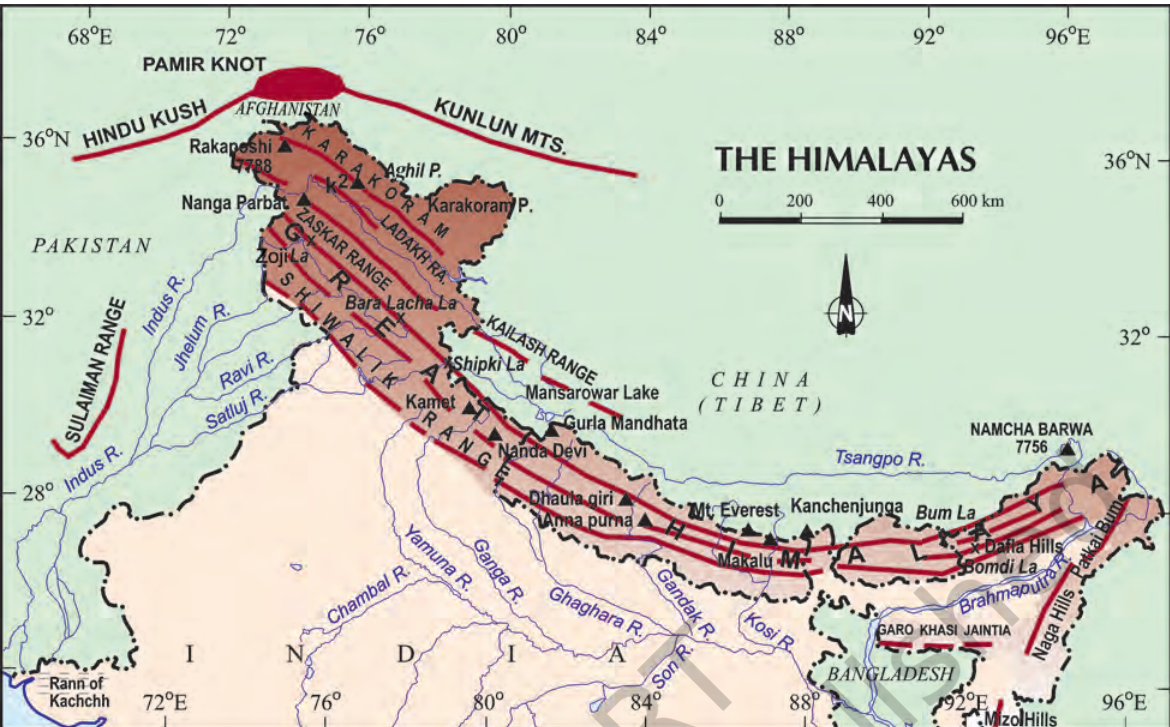
Himalayan Ranges of India: The Himalayan mountain ranges form the northern boundary of the Indian subcontinent. Acting as a natural barrier between India and Central Asia, these young fold mountains stretch over 2,400 kilometres , shaping India's climate, biodiversity, and socio-cultural fabric.
In the UPSC exam, static and analytical questions on Himalayan ranges are frequently asked, making it a crucial topic for Prelims and Mains. Keep reading to explore the formation, divisions, and significance of the Himalayan ranges of India.Formation of Himalayan Ranges
The Himalayas were formed by the collision of the I ndian Plate with the Eurasian Plate millions of years ago. Around 500 million years ago, the region was covered by the Tethys Sea. During the Cretaceous period, the Indian Plate drifted north from Gondwana and eventually collided with the Eurasian Plate. This collision generated immense pressure, causing the Earth's crust to fold and creating the Himalayan ranges. As the seabed sediments folded and uplifted, the mountains emerged, a process that continues today, with the Himalayas rising annually by about 5 millimeters . The range consists of sub-ranges such as the Greater, Lesser, and Trans-Himalayas, with fossilized marine life found in areas like Karakoram. ?si=RfevBbHRs21W4cjVDivision of the Himalayas
The Himalayan Ranges of India are traditionally divided into three distinct regions based on altitude and vegetation, which are further subdivided into smaller ranges, each with unique characteristics.Trans-Himalayas
The Trans-Himalayas refer to the mountain ranges located to the north of the Great Himalayan Range . Stretching about 1,000 km in an east-west direction , these ranges have an average elevation of around 3,000 meters above sea level. The Trans-Himalayas are home to some of the highest peaks and largest glaciers in the world. Key ranges that constitute the Trans-Himalayas include the Karakoram Range, Ladakh Range, and Zaskar Range.The Himalayan Ranges
The Himalayan Ranges, also known as Himadri or Himavan, are the youngest mountain range in the world , primarily composed of uplifted sedimentary and metamorphic rocks. The ranges are divided into three main sub-divisions: Greater Himalayas, Inner Himalayas, and Shiwalik:The Greater Himalayas (Himadri):
- Altitude: 6,000 meters and above
- Vegetation: Alpine meadows and glaciers, with little to no vegetation at higher altitudes
- Subdivisions : Includes the Zanskar Range, Ladakh Range, Karakoram Range, and Himachal and Uttarakhand Ranges.
- Features: The Inner Himalayas consist of the highest peaks, including Mount Everest, and are characterized by permanent snow, glaciers, and high-altitude plateaus.
The Middle Himalayas (Himachal):
- Altitude: Between 3,700 and 4,500 metres
- Vegetation: Temperate forests, including oak, pine, and deodar
- Subdivisions : This region includes ranges like the Dhauladhar Range, Pir Panjal Range, and Mahabharat Range.
- Features : The Middle Himalayas are marked by rugged terrain, with deep valleys and steep slopes.
The Outer Himalayas (Shivaliks):
- Altitude : Between 900 and 1100 metres
- Vegetation: Dense forests of tropical and subtropical plants
- Subdivisions : The Shivaliks are divided into various smaller ranges like the Terai, Bhabar, and Madhupur Hills.
- Features: This region is characterized by low hills, valleys, and river plains formed by the erosion of the higher Himalayan ranges.
Eastern Himalayas (Purvanchal)
The Purvanchal region, also known as the Eastern Himalayas , consists of a series of relatively low hills from Arunachal Pradesh in the north to Mizoram in the south. These hills take a sharp southward turn at the Dihang Gorge due to the Syntaxial Bend, transitioning from the towering peaks of the central Himalayas to gentler slopes. Prominent ranges include the Patkai Bum, the northernmost range, the Naga Hills, and the Mizo Hills (Lushai Hills).| UPSC Mains PYQ 2016: “The Himalayas are highly prone to landslides.” Discuss the causes and suggest suitable measures of mitigation.[200 Words, 12.5 Marks] |
Himalayan Ranges from North to South
The Himalayan Ranges, from north to south, can be broadly categorized into different sub-ranges based on their geographic location, elevation, and geological characteristics. Here are the Himalayan ranges on map:
- Trans-Himalayas : This range lies to the north of the Great Himalayas and includes regions like Ladakh, Karakoram, and Zanskar. These mountains have an arid, desert-like climate with scanty vegetation due to their high altitude and low rainfall.
- Great Himalayas: Also called the “roof of the world,” this part contains some of the highest peaks like Nanda Devi. The Great Himalayas are significant for being a continuous and nearly impenetrable barrier blocking cold winds from Central Asia.
- Middle Himalayas (Himachal) : Known for their fertile valleys and terraced farms, this range houses popular rivers like Beas and Ravi. The Middle Himalayas have diverse vegetation, including pine and deodar forests, which provide valuable timber resources.
- Lesser Himalayas (Shivaliks): The southernmost region, these ranges are closer to the Indo-Gangetic plains and are characterized by sediment deposits that form fertile lands vital for agriculture.
Significance of the Himalayas Mountains
The Himalayan Ranges of India hold immense significance, contributing to India's natural and socio-economic wealth. The Himalayas are the lifeline for India in multiple ways:- Climatic Influence: The Himalayas block cold winds from Central Asia, giving northern India a warmer climate. They also play a crucial role in monsoon patterns, leading to rainfall that supports Indian agriculture.
- River Systems: The Himalayas are the source of some of the major rivers in India, including the Ganges, Yamuna, and Brahmaputra. These rivers provide water for irrigation, hydroelectric power, and drinking water.
- Biodiversity: The varying altitudes and climates support diverse flora and fauna. The Himalayas are home to rare species such as the snow leopard, red panda, and Himalayan musk deer.
- Tourism and Economy : For centuries, the Himalayas have been boosting local economies through eco-tourism, adventure tourism, and spiritual tourism. Hill stations like Shimla, Manali, and Darjeeling are popular among both domestic and international tourists.
- Cultural and Spiritual Heritage: The Himalayas are sacred in Hinduism and Buddhism, housing shrines, temples, and monasteries, including the famous Kedarnath, Badrinath, and Hemis monasteries.
| UPSC Related Articles | ||
| NCERTs for UPSC CSE | Mission Karmayogi | Circular Economy |
| UPSC Mains Syllabus | Cooperative Federalism | Sendai Framework |
Himalayan Ranges of India FAQs
How many Himalayan ranges are there in India?
The Himalayas are divided into the Greater Himalayas (Himadri), Lesser Himalayas (Himachal), and Outer Himalayas (Shivalik), each with distinct characteristics.
Which are the Himalayan states in India?
Himalayan states in India include Uttarakhand, Himachal Pradesh, Arunachal Pradesh, Manipur, Meghalaya, Mizoram, Nagaland, Sikkim, Tripura, Assam and West Bengal. Also, the Himalaya range is spread across the Union Territories of Jammu & Kashmir and Ladakh.
Which is the highest peak in the Indian Himalayas?
The highest peak in India is Kanchenjunga, located in Sikkim, standing at 8,598 meters.
What rivers originate from the Himalayas?
Major rivers like the Ganges, Yamuna, Indus, and Brahmaputra originate from the Himalayas.
Which are the significant peaks in the Himalayas?
Major peaks include Mount Everest, K2, Kangchenjunga, Nanda Devi, and Namcha Barwa, among others.
Talk to a counsellorHave doubts? Our support team will be happy to assist you!

Check out these Related Articles
Free Learning Resources
PW Books
Notes (Class 10-12)
PW Study Materials
Notes (Class 6-9)
Ncert Solutions
Govt Exams
Class 6th to 12th Online Courses
Govt Job Exams Courses
UPSC Coaching
Defence Exam Coaching
Gate Exam Coaching
Other Exams
Know about Physics Wallah
Physics Wallah is an Indian edtech platform that provides accessible & comprehensive learning experiences to students from Class 6th to postgraduate level. We also provide extensive NCERT solutions, sample paper, NEET, JEE Mains, BITSAT previous year papers & more such resources to students. Physics Wallah also caters to over 3.5 million registered students and over 78 lakh+ Youtube subscribers with 4.8 rating on its app.
We Stand Out because
We provide students with intensive courses with India’s qualified & experienced faculties & mentors. PW strives to make the learning experience comprehensive and accessible for students of all sections of society. We believe in empowering every single student who couldn't dream of a good career in engineering and medical field earlier.
Our Key Focus Areas
Physics Wallah's main focus is to make the learning experience as economical as possible for all students. With our affordable courses like Lakshya, Udaan and Arjuna and many others, we have been able to provide a platform for lakhs of aspirants. From providing Chemistry, Maths, Physics formula to giving e-books of eminent authors like RD Sharma, RS Aggarwal and Lakhmir Singh, PW focuses on every single student's need for preparation.
What Makes Us Different
Physics Wallah strives to develop a comprehensive pedagogical structure for students, where they get a state-of-the-art learning experience with study material and resources. Apart from catering students preparing for JEE Mains and NEET, PW also provides study material for each state board like Uttar Pradesh, Bihar, and others
Copyright © 2025 Physicswallah Limited All rights reserved.
Get App






